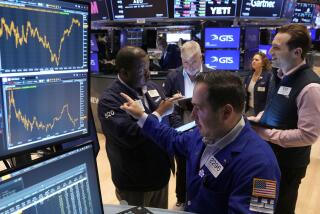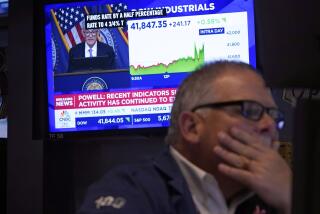2 Dissent as Fed Lets Rate Stand
WASHINGTON — Federal Reserve policymakers acknowledged Tuesday that the nation’s economic recovery remained wobbly and could be damaged by war with Iraq. But with two members opposed, they voted to leave their signal-sending interest rate unchanged for a 10th straight month.
Policymakers left the so-called federal funds rate, the interest that banks charge each other for overnight loans, at a four-decade low of 1.75%, where it has been since December. In a statement, they said the economy was growing at a “moderate pace” and that rates already should be low enough to make it grow faster.
But the central bank, for the first time, revealed immediately after the vote that there had been disagreement over the rate decision. It said that of the 12-member board, Fed Gov. Edward M. Gramlich and Dallas Federal Reserve Bank President Robert D. McTeer Jr. wanted to lower rates.
Some analysts interpreted the disclosure as a sign the Fed was preparing for further cuts--perhaps dramatic ones--if the economy weakens.
“The question is no longer whether, just when,” said Dominic Konstam, chief of interest rates and Treasuries at Credit Suisse First Boston in New York.
The latest Fed decision came amid worrisome new signs that American consumers, whose purchases have kept the economy afloat in recent years, may be getting cold feet.
The Conference Board, a New York-based business-research group, reported Tuesday that its consumer confidence index fell 1.2 points in September to 93.3, its fourth consecutive monthly drop. And the Bank of Tokyo-Mitsubishi said its index of chain store sales tumbled 1.7% in the week ended Sept. 14 and 2.7% from a year ago. The measure’s rise until recently was widely cited as evidence that consumers would keep buying, come what may.
Already bearish investors reacted to the Fed decision by pushing stock prices lower. The Dow Jones industrial average lost 189.02 points, or 2.4%, to close at 7,683.13, its lowest level in four years. Nasdaq hit a six-year low of 1,182.17, and 10-year T-notes fell to another 40-year low, helped by reports that governors wanted a rate cut.
Analysts said central bank policymakers were influenced by at least three factors in deciding to leave rates unchanged.
First, despite renewed signs of weakness, the economy is likely to post a healthy 3.5% to 4% growth rate in the nearly complete July-through-September quarter, and so needs no additional bucking up for now.
“The Fed thinks the economy is improving--that there’s nothing abnormal about this recovery--so it doesn’t need to cut further,” said Dean Maki, a former Fed staffer and now an economist with Boston-based Putnam Investments.
Second, with the government considering war with Iraq, the Fed should not squander what little flexibility it still has to reduce interest rates. Fed policymakers cited the move toward war in explaining their latest decision, saying that “considerable uncertainty persists” about the economy’s recovery, “owing in part to the emergence of heightened global risks.”
Finally, persistently low interest rates are producing some unexpected--and unwanted--side effects by scrambling the finances of Fannie Mae and other mortgage giants and forcing such companies as IBM Corp. to contribute more to pension funds to ensure they can earn enough at such low rates to cover all their retirees.
“People become very excited about low rates without thinking it all the way through,” said Jay Mueller, director of fixed income and chief economist at Strong Capital Management, a Milwaukee-based mutual fund company. “For every borrower who gets a good deal, there is a lender who’s making less.”
The Fed’s decision to keep the funds rate unchanged means commercial banks will leave their prime lending rate--the interest that they charge their most favored business customers and that is used as a benchmark for many other types of loans--at 4.75%, its lowest level since November 1965.
Despite the low rates, American business has been reluctant to borrow and invest in new equipment. The nation’s manufacturing sector, hard hit by last year’s recession but on the mend earlier this year, lost ground last month and began laying off workers again.
Businesses, therefore, have left it to consumers--who account for two-thirds of the nation’s economic activity--to prop up the economy. They have done so largely by snapping up no-interest financing deals for cars and low mortgage rates for homes. But some analysts wonder how much longer that can last.
“There is a limit to how many new cars you need,” said Sung Won Sohn, chief economist with Wells Fargo & Co. in Minneapolis.
Veteran Fed watchers were surprised Tuesday by news of dissent on the central bank’s policymaking Federal Open Market Committee. Although McTeer, the Dallas Fed bank president, has openly disagreed with Fed Chairman Alan Greenspan in the past, Gramlich, a Fed governor and former academic economist, is considered a cautious centrist.
Goldman Sachs & Co. analysts said the 10-2 vote marked the first time since May 1998 there had been two dissents and the first time a governor--as opposed to a Fed bank president--had voted against Greenspan since November 1995. It also was the first time the central bank had disclosed the vote immediately after it happened.
More to Read
Inside the business of entertainment
The Wide Shot brings you news, analysis and insights on everything from streaming wars to production — and what it all means for the future.
You may occasionally receive promotional content from the Los Angeles Times.










